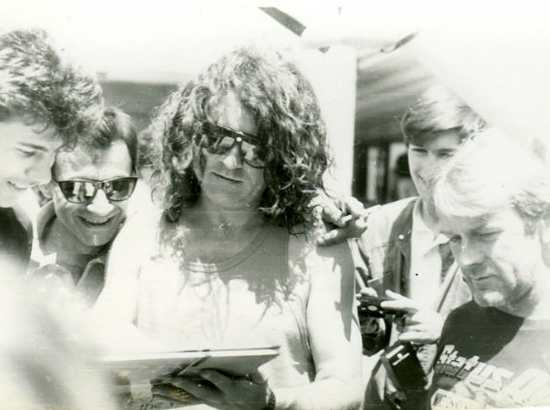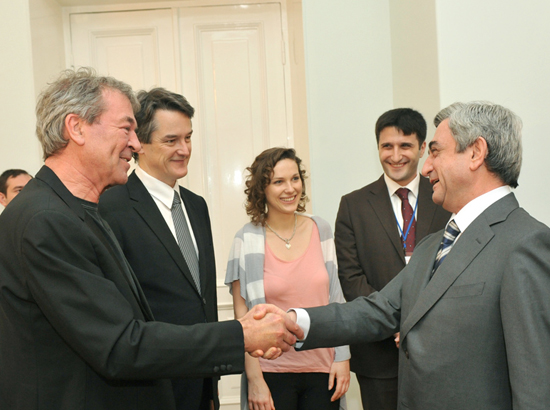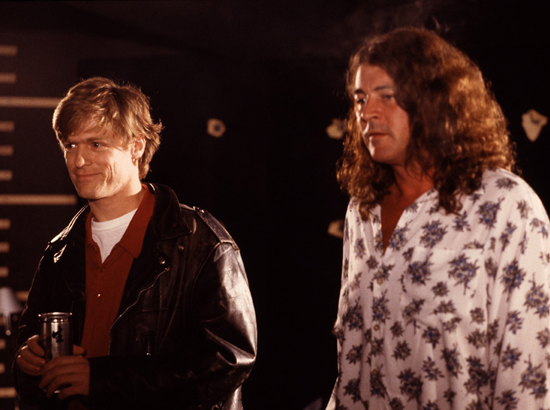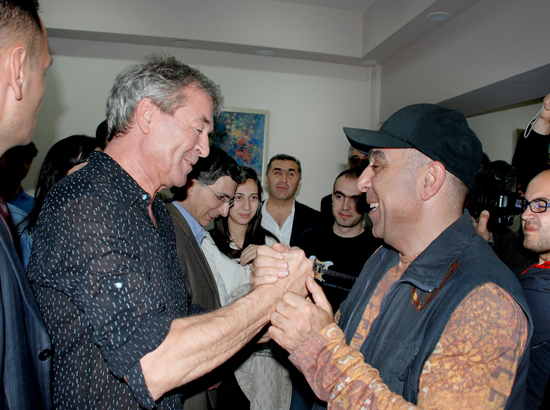Ian Gillan's four concerts were not simply a major music event in 1990 in Yerevan. The concerts proved that the world was changing and "iron curtain" was about to disappear.
One can hardly imagine how difficult the logistics of such concerts was in Yerevan of 1990. It would be no exaggeration to say that the organizers, Vahan Karapetyan and his friends, were real heroes. In March 2010, when organizing Ian Gillan's concert with the State Philharmonic Orchestra of Armenia, Mediamax had to deal with numerous major and minor issues. Just imagine what it might have been like back in 1990. These people should be paid tribute to. Without their effort, Ian Gillan would never call Armenia his "spiritual home".
Director of “KMO” Ltd. Vahan Karapetyan
In 1990, I worked with Arvest organization that specialized in concert management and promotion. The minute we heard that Ian Gillan was going to tour the Soviet Union we knew we should invite him to Armenia as well. We knew about the active role he had plaid in Rock Aid Armenia campaign initiated by Jon Dee, hence, Gillan's visit to Armenia would be of particular significance.
At that time, the Supreme Council of Soviet Armenia was presided by Hrant Voskanyan. We asked him to receive the guests. The meeting was scheduled to last 30 minutes but it came to three hours instead. We talked of various things: the situation in Armenia, the earthquake, literature, music, and so on. At the end of the meeting, Ian Gillan presented Hrant Voskanyan with a gift: the Earthquake Album released within Rock Aid Armenia project.
Gillan was also received by Mayor Norik Muradyan in Spitak. Though a year and a half had passed after the quake, and the damages were not that visible already, the musician was obviously very compassionate about what he saw and what he heard people tell him. Ian Gillan said that he would like to hold an international music festival in Spitak. It’s a pity this idea was not realized.
It was four of us who organized Gillan's visit and concerts – with no money, state officials or sponsors to back us. We received the funding from the ticket sales.
We had to bring all the necessary equipment for the concert from the Baltic countries, as Armenia had none of its own. No organization in Armenia could ensure the security during the concert, either, so we had to employ security guards from Poland.
This was an enormous amount of work. There were 30 people in the group: musicians, technical staff, security officers, interpreter, etc. They all were extremely simple and nice people, we received no complaints of any technicalities ever.
The decision to hold four concerts was due to the fact that the dates of the tour were already fixed by the USSR’s State Concert Agency, Gosconcert, and we had to fit in. The enterprise was absolutely unprofitable. We had estimated that to gain profit, we would have to sell at least 80% of tickets, whereas we managed to sell only 60-70%. This was barely enough to cover the expenses. However, the profit was the last thing on our mind. It was much more important to have Ian Gillan see Armenia, meet our people whom he had helped when the disaster struck. 
Vahan Karapetyan and Ian Gillan.
Photo from A. Mitinyan's archive.
I find it hard to describe what I was feeling, a blend of admiration and pride.
Once, musician Ara Gevorgyan asked me if his Rally band could host one of the dinners for our guests. They invited Gillan and his musicians to a restaurant on the way to Jrvezh (outside Yerevan). We had been sitting for rather a long time when sounds of duduk were heard from a room next door. Gillan said that he wanted to invite the duduk player to his next day's concert. Frankly speaking, I was sure he would forget about the request. But Ian repeated his request first thing in the morning. I called Ara Gevorgyan who invited Arsen Grigoryan, the duduk player. Arsen Grigoryan performed at the concert that night.
Musician Ara Gevorgyan
The Rally band that I was performing with those days often played covers of the Deep Purple. We knew most of their hits by heart. As we learned that Gillan was to come to Armenia, all we could hope for was to be at the airport when he arrives and attend the concerts. Sitting at the same table with him and performing on the same stage was beyond any dream.
It all started the day when we invited Gillan and his musicians to dinner. A duduk player was performing at that restaurant. Hearing the music, Gillan said he wanted to have duduk during his concert. 
Ian Gillan and Ara Gevorgyan in Yerevan, 2010.
Photo from A. Gevorgyan's archive.
I didn't take it seriously first. But the next day Gillan insisted and I called the duduk player Arsen Grigoryan, calling him to Sport and Concert Complex for a rehearsal. I explained it to Gillan's keyboard player that he should only press one key and nothing more. He seemed to agree, but then, as a musician, he could not help himself and did come in with his own accords. I tried to imply it delicately, and in response received an offer to play myself, with him standing by me. This is how both of us, Arsen and I, performed at the concert. There is no point even trying to describe my feelings.
During those days the Artistic Director of the Chamber Theater Ara Yernjakyan called me, asking if he could invite Gillan and his group to the theater. By midnight, we came to the theater that seemed to be seized with real craze, in the best sense of the word. Hrant Tokhatyan, Mikael Poghosyan, other musicians and actors were there. Till the very morning, Gillan was singing and we were playing, performing his Smoke on the Water. No words can describe that.
I remember Gillan being very surprised at our tradition toast “to friends who are away”. He was very surprised and said: "What amazing people you are to have such a toast".
In 2010, Gillan offered me to take part in creating “Holy Water” - one of compositions of
WhoCares supergroup set up especially for raising funds for Gyumri N6 music school construction. I was of course happy to agree, and he sent me the Holy Water track, requesting to give it some Armenian “flair”. This time, I invited a good friend of mine and a famous duduk player Arshak Sahakyan who did a great job for this record.
Jon Dee, Founder of Rock Aid Armenia, Founder and Managing Director of Do Something!
On December 7, 1988, I got a phone call from Washington telling me about an earthquake that had just taken place in Armenia. I was asked to use my connections and get the first foreign film crew into Armenia. The aim was to get independent footage out to the international aid community. We succeeded in getting the crew in but we also ended up where the footage spread like wildfire in the global media.
On seeing the footage, I decided to start a fundraising initiative called 'Rock Aid Armenia'. Pink Floyd's David Gilmour was the first person to get my call and was the first star to come on board. But without doubt, the one person who did more than any other to help the project was Deep Purple's lead singer Ian Gillan.
Jon Dee and David Gilmore, 1989.
Photo from Jon Dee's archive.
Back in May 1990, I visited Armenia to travel to the earthquake zone with Ian. I had just released 'The Earthquake Album' which had gone 'gold' in the UK and together with Ian I wanted to see what was happening on the ground in the earthquake zone.
The timing was fortunate. Ian had some concerts planned at the Sports and Concerts Complex in Yerevan and I needed to visit Armenia to meet with people on the ground.
Getting the visa to visit Armenia turned out to be a lot easier than for my first trip there. The success of the album and our top 40 'Smoke on the Water' single meant that I had got to know the UK's Soviet Ambassador and his staff. He had organised for the deputy head of the Academy of Sciences to sponsor my trip. That opened up a lot of doors.
This time around, instead of the KGB monitoring me to see what I was up to, they were following me to ensure that everything was okay. The funniest experience happened at Moscow airport when I was waiting for the domestic Aeroflot flight to Yerevan. A man in a pink suit was reading an English newspaper. He was failing badly in his efforts to look like a western tourist. On looking at him more closely, it turned out that his newspaper was the wrong way up. Unless he could read upside down, there was no way that he could read the paper. From the other side of the room, I silently motioned to him that he needed to turn his newspaper the correct way. He looked at the newspaper, laughed at himself, winked back at me and smiled. I smiled back.
The plane itself had seen better days and was so full that some people were standing. Someone even had some chickens with them. It was not what I was used to on a British flight. My personal assistant questioned whether we should get off the plane. The state of the plane prior to take-off had worried me but the landing was far worse. On approaching Yerevan I couldn't believe how high we were above the airfield. We suddenly dropped from the sky and hit the ground so hard that baggage fell out of the overhead lockers. As the plane bounced on the tarmac, it was a heart stopping moment. Even the locals looked dazed.
What surprised me was that the passengers waited for the pilots to disembark before they did. It came as no surprise to see two pilots who looked like they had drunk vodka for the whole trip to Armenia. Looking at the state of the plane, it was probably the only way they could get up enough courage to fly the thing. On disembarking from the plane, we saw an old man with a big iron bar hitting the wheels. As he hit each wheel and saw it still had air in it, he shrugged. Safety check completed, he walked away.
On reaching our hotel, we arranged to catch up with Ian the next day. Complete with a full entourage, we got in to a beautiful limousine that looked like it was straight off a 1950's Hollywood set. It was a long drive to Spitak, so Ian and I took the time to catch up about the Rock Aid Armenia project. We had a long conversation and it was nice to talk with nobody else around.
Ian Gillan and Brian Adams, 1989.
Photo - Michael Putland.
We weren't sure what to expect of the earthquake zone. Would anyone have any time to show us around? What was the infrastructure going to be like? Would we be intruding on people's personal space? What would we find? So many questions were going through our minds.
The first thing we were shown was a memorial put up to recognise those who had died during the earthquake. As we walked around the surrounding area, we noticed that the gravestones in Armenia are very different to those in the West. They had very lifelike etchings of the faces of the people who had died. What struck us hard were the gravestones showing children. Ian and I were shown a gravestone that had the images of a whole family. There were beautiful images of a mother, her children and their father. All had died. We had to turn away. As we did so, we saw countless other gravestones showing similar faces. The experience triggered much emotion that we found hard to suppress.
Jon Dee and Pat Cash, 1991.
Photo from Jon Dee's archive.
We were then taken to the international village in Spitak where two things happened that affected us even more. We firstly met an old lady who had been given a small demountable one room home. We were told that she was lucky to have it. On entering it, we came across a wall of photos. She cried as she pointed out all her relatives. Our translator told us that they were all dead.
She spoke to us in a language that we didn't understand. We didn't need to. Her voice and the distraught sobs that came from deep within her were universal in what they conveyed. In her old age, she had lost her entire family. You could sense her desperately reaching out and so Ian gave her the loveliest hug. He looked into her eyes and didn't say anything. He didn't need to. I held her hands and she put her head on my shoulder. I felt her tears on my neck. I was only 27 and had never experienced the grief of a stranger like that. The grief filled the room and on leaving her, the cold air hit us as much as our emotions.
What Ian and I saw next hit us harder still. We visited a school in a temporary building. We were taken in to a classroom, which the translator told us was "the orphans class". It turned out that the majority of the children there had lost all their family. Mothers, fathers, brothers, sisters, aunties and uncles. The look in the eyes of these children affected me so profoundly that I still cannot talk about it publicly to this day. Looking in their eyes you could see they were still alive, but you sensed that inside they had emotionally died. I find myself crying as I reminisce and write these words. Back then I found it impossible to fathom the grief that those children were experiencing. It cut to my soul back then and the memory of that moment still does the same today.
We went back to our car. Nobody spoke. We couldn't. We had been left in shock from the experience. As we drove around the ruins, one couldn't help but wonder how on earth a society could bounce back from such devastation and grief. We pulled over so that I could film an interview for MTV. I remember saying that I thought the area would need help for decades to come. Little was I to know that Ian and I would be back there 20 years later still trying to do our small bit to help out.
A total contrast greeted us when we were told that a lunch was being held in our honour. Amongst the devastation, a local group of dignitaries and reconstruction managers wanted to personally thank us for what we were trying to do. The generosity of the food and the warmth of the words left us feeling a great depth of gratitude towards our hosts. Despite the terrible situation that our hosts were in, they reached out to Ian and I in a way that left us deeply moved.
We reached a time where we had to leave in order to get Ian back to the first of his concerts in Yerevan. In the car on the way back, we were all totally silent. Nobody could talk. Each of us was in our own world processing what we had all seen. It was a feeling that I have experienced at funeral wakes. At some point, somebody said something that made us all laugh and we then took to talking about the positive things that we had seen. We all spoke of our deep affection for the people that we had met. It is a feeling that Ian and I have experienced again and again at the lunches and dinners that we have had in Armenia since that first visit together.
The mood in the car slowly lifted and we soon found ourselves at the venue. That night I stood at the back of the stage watching Ian perform to a sold out venue at the Sports and Concerts Complex. When the first note sounded there was an incredibly powerful outburst of emotion from the crowd. Ian reacted with the best show that I have ever seen him perform.
The next day we were given a tour of Yerevan and had a quieter day. We needed it. The experience of visiting the earthquake zone had left an indelible impression on us.
What became clear to me during our lunch in Spitak and the trip itself was that the success of Rock Aid Armenia was not to be judged in how much money it had raised. I now realise that its main success had been to boost people's morale in the earthquake zone. 17 months after the earthquake, the media had gone home and Armenia was no longer being talked about overseas. But to know that some of the world's biggest rock stars were still trying to help raised people's spirits over there. They came to realise that they hadn't been forgotten.
During one of the toasts at the lunch in Spitak, somebody remarked about the importance of music to the people of Armenia. They said that on the day of the earthquake the music had died. They said that things would only be healed when music had found its way back into the hearts of Armenians. When I decided to re-release the Rock Aid Armenia version of 'Smoke on the Water', it was one of the reasons why I was so keen to fund a children's music project in the earthquake zone. With the help of Mediamax and the Fund for Armenian Relief, we decided to try and rebuild the music school in Gyumri. 
Ian Gillan and Jon Dee in Yerevan, 2010.
Photo: Mediamax.
That school is now being built and the efforts that Ian and I began all those years ago will bring about a positive outcome that brings music into the hearts of young Armenians. That we are doing this in partnership with our Armenian friends at FAR and MediaMax makes it even more special for us.
It has been an honour for me to have been taken in as a friend of Armenia. It is a place that holds a special place in my heart. I know that I can speak for Ian when I say that what we experienced all those years ago will stay with us for the rest of our days.
Ian Gillan and Jon Dee meet with Armenian President, 2010.
Photo: Armenian President’s Press Office.
An extract from "Ian Gillan: Glory Road" book
On May 17-20, Armenia applauded Gillan. There were no barriers between the stage and the audience, Ian shook hands with people during the concert, gave out signatures, etc. There were only two security officers at the sides of the stage, keeping order. The fans were screaming, chanting Gillan’s name, the atmosphere was fantastic. On the first evening, before “Ain't No More Cane On The Brazos” song, Gillan said it was a dedication to the innocent victims of the earthquake in Armenia.
On the third day, amidst the concert, while Gillan was shaking hands with the fans, they pulled him off the stage. The two security officers jumped down to hold the musician back, and when Ian came back to the stage, his famous sheriff's badge had disappeared from his chest. Seeing it, he laughed, said something and kept singing. All this time, the musicians of the band kept playing unruffled.
During the last concert, a musician was invited to the stage who played the duduk (Armenian national instrument) for about 10 minutes. The beautiful melody smoothly merged into “Ain't No More Cane On The Brazos”. The people sang with Gillan, and the "floating" fires of lighters could be seen all across the hall. By the end of the concert, a girl sprang out of the crowd and literally threw herself on Gillan, hugged him with her arms and legs and kissed passionately on the lips. The security officers could hardly separate the fan from the singer. Ian smiled, hugged the girl tenderly and gestured the security officers to take the girl down to the fan zone.
During all the four concerts, the tracklist was the same: Gut Reaction, Black Night, Living For The City, Strange Kind Of Woman, Ain't That Loving You Baby, Nothing To Lose, Ain’t No More Cane On The Brazos, I Thought No, Knocking At Your Back Door, Puget Sound, Sweet Lolita, Trouble, New Orleans, Lucille, Smoke On The Water.
“Ian Gillan Superstar”
In May 1990, the Soviet Ekho Planety magazine published an interview titled Ian Gillan Superstar. The interview was dedicated to the launch of the musician’s tour across the Soviet Union. We present you some extracts from the interview made by TASS correspondents Andrey Biryukov and Alexander Sisnyev.
***
Our conversation before the USSR tour wasn't our first meeting with Gillan. We met him at the presentation of Rock Aid Armenia charity single. At that time, the singer spoke about our country highly and was interested in the developments there. So when our request for an interview came, Ian Gillan obliged with responding immediately.
We drove for an hour and a half from London to come to a small town. Here, at the Reading Lane street, the Old Manor House was the residence of the singer. Hardly did the car drive up to the house that the host appeared at the door, dressed in a pink T-shirt and a pair of blue jeans. A four-pawed pet was standing by him, wearing a plastic socket of unknown purpose at his collar.
“It's Rufus”, Ian explained noting our surprised glances at the extraterrestrial creature. “He hurt his front paws and doesn't stand bandages - scratches them off at once. I had to put this intricate device on him - for his own good”.
Coming into the house, we saw a real pet kingdom. Two cats, a canary, a large aquarium full of small fish of most unimaginable colors. “Everyone has its own name”, kindly informed Gracie, Gillan's 6-year-old daughter. Besides the poor Rufus, three more mongrels were darting about the room. 
Ian Gillan, 1989.
Photo: Michael Putland.
“Well, we wanted to take a dog”, said Ian, “but when my wife and I went to an asylum for homeless animals and saw these four sufferers in the same cage, we couldn't but take all of them”.
Gillan invited us see the house, adding with pride that he made many things himself, from woodwork to sewage piping.
***
- Ian, as far as we know, the USSR tour was scheduled for March. We had informed our readers about it and, to be honest, felt guilty before the Soviet rock fans when the schedule changed. What happened? Issues with logistics?
- My Naked Thunder album is to blame, if we can say so. I thought I would manage to come to the USSR in March and set off to Europe afterwards to do the promotion. But the German recording company postponed the release of the CD till July, and we decided to do some more work in the studio.
- Will the Soviet rock fans hear these new works?
- Yes, we included some new compositions into the tour program. But we'll also play the works that have passed the time test, the more popular hits from Deep Purple and Ian Gillan band, rock classics, such as "Lucille" by Little Richards and many others. We’re curious to see how our music will be taken in your country, I hear there are cities in the tour that do not see many Western groups perform.
***
- It’s no secret that many of your colleagues have had problems with equipment in the USSR. They had to carry multi-ton luggage with them....
-We will mostly use the same equipment that the Black Sabbath did during their Leningrad tour, but we will certainly bring some with us, too. I hope the concerts will be successful, and people will be happy with them.
***
- I remember that your performance as Jesus Christ in Webber's musical was justly named the "most significant occurrence in the music". The rock opera has fantastic, incredible popularity in our country, even though the official authorities for culture pretended such piece of music never happened. Can you tell us a bit more about this work of yours?
- I was invited to take part in the recording of Jesus Christ Superstar rock opera by Tim Rice. He wasn't as famous as Andrew Lloyd Webber, meanwhile, it was Tim who is mostly responsible for the success of the work. He researched the subject profoundly and came up with an excellent script. I actually think that in terms of music, it is not so much the composer’s merit, but rather that of the artists and singers, it is their improvisation skills that gave the opera the sound it is so popular for. Our partnership with Webber did not continue after the Jesus Christ. Later, I was offered to sing General Peron's part in his new work, the Evita. Yet the music seemed to be more in a cabaret style, and I didn't accept. There were some personal motives, too: Webber was gaining more and more power, while Rice's authority weakened. I think it is not fair, and I am good friends with Tim…
***
Setting off to the USSR, we hope that the trip will be very elucidating for us, Gillan says.
"We want to meet the different nations of your country, to get to know their characters and cultures. I am sure we'll see a lot and learn a lot, too. It's one thing to read about the Soviet Union in the papers, listen to politicians and businessmen, and it is completely different to talk to people in the street. I am interested in the routine philosophy of ordinary people, what is that they like and dislike...
Ian Gillan, 1990.
Photo: Ian Gillan's Official Site on Facebook.
Artistic Director of Chamber Theater Ara Yernjakyan
About 50-60 people gathered in the theater, and many of them did know already Ian Gillan himself was coming.
Our theater had an active jazz club back then. Our quartet mainly played in the Blue Hall, their performances were well known, and people would regularly come here at 10 p.m. We had great nights there.
When Gillan came up, the theater started screaming. He came with his musicians. The idea was to have a get together and share a drink, we could not imagine he would actually sing.
At first, it was his and our musicians singing and playing. Later, Gillan himself started singing. It was a crazy night. One could not tell who’s singing, who’s dancing, six people at a time could find themselves at the piano.
We could not seat many people in that hall, so only a close group of friends gathered. And everyone new: a miracle will happen.
Founder of Hayas rock band, composer Artur Mitinyan
Fans, including our group, met with Gillan in Dvin hotel where he was staying. We were standing quietly by the entrance, as Gillan appeared. He was very friendly and simple and he came up to us himself. 
Photo: from A. Mitinyan's archive.
I was carrying a magazine, I don't even remember now who was featured on its cover. I stretched it out to get an autograph. And our drummer Rambo didn't have anything at hand, so he held out his passport, and Gillan signed it.
Former employee of the Sports and Concert Complex (senior engineer of Sports Events Division) Vahan Manoyan
My friends and I were big fans of Deep Purple. It was great enough for us to see Ian Gillan on our stage, but our joy doubled when we were given a chance to talk to him after the concert. We had the head of our department of stage equipment do the interpretation, he was a former pilot and he spoke English.
Gillan seemed at ease at the meeting. We offered him Armenian wine that he liked very much. He said that from behind the Iron Curtain the USSR seemed to be evil, but being here he was meeting many wonderful people. It had surprised him that we loved rock music so much.
His band members had brought everything they needed with them, and Gillan could feel at home in the dressing room. I remember that they had brought lots of beer that they were drinking all the time. They also brought bicycles and basketball balls: they were riding bicycles in the backstage.
The concert went very well. The Smoke on the Water was an incredible performance, and I couldn’t believe I was actually seeing Ian Gillan on stage. Unfortunately, the concert hall was not at its fullest. I remember that a few days after Gillan’s concert, an Uzbek band Yalla was performing on the stage, and the hall was packed.
Director of Mediamax Ara Tadevosyan
In spring 1990, I was on my way home from school, and was about to reach my building when I saw something that made me freeze. It was a large white poster on the wall of the flower store in the beginning of Baghramyan avenue that read: IAN GILLAN IN ARMENIA: MAY 17-20, 1990. I found it hard to believe this was a real announcement and not somebody’s prank. It seemed unbelievable. I was a fervent fan of the Deep Purple, and my brain refused to imagine that in a month I would be able to see and hear Ian Gillan in Yerevan.
I went to the first concert with my classmate Eliza who was one of few heavy metal fans of Yerevan. Our seats were on the podium, but after a few songs we went down and continued to listen to the concert standing. To tell the truth, I have had few impressions of the first concert, it was the last, the fourth one that truly remained in my memory.
I actually got to the last concert by chance. I was at a birthday party with my classmates. It suddenly turned out that the hosts had tickets to Gillan’s concert and didn’t want to go. We decided to take the tickets and go to the concert, all the more since we were not very far from the Sports and Concert Complex. There were three of us: Avik Eloyan, Nairi Petrosyan and myself. As we went outside, a heavy thunderstorm broke out, and we ran along the Kievyan Bridge under the pouring rain. Soaking wet, that’s what we were as we entered the concert hall. We immediately took the best “posts” by the stage, and when the concert began, it was obvious my feelings were not to be compared to the ones during the first concert. It was all different here: you could feel the energy coming not only from Gillan and his musicians but also from dozens of people dancing and screaming next to us. Gillan bent from time to time to shook hands with the fans. I was lucky, too. He looked at me and gave me his hand. It seemed like a dream… Avik spent most of the concert sitting on my shoulders, but it did not even inconvenience me. 
Ian Gillan, 1990
Photo: Ian Gillan's Official Site on Facebook.
It was unforgettable when a duduk player came on to the stage, and Gillan said that the next song was dedicated to the memory of the victims of Spitak earthquake. Everybody in the hall lit lighters and matches, we had seen something like that only in foreign movies.
After the concert we decided to try our luck and get Gillan’s signature. We went to the staff-only entrance of the Complex, where a few dozens of people had already gathered. We were waiting for a long time, for about two hours. But Gillan did not come out, and we were not allowed to enter. Finally, when it was almost midnight, we decided that Avik and I would go home, while Nairi would stay and take signatures for all of us. As I came in, I was overtaken by the strong smell of valocordin, drops for hear. I was 14 , and it was the first time I had come home so late, past midnight. My mom was so happy to see me safe and sound that she wasn’t even mad at me. I was already in bed when my father came home. It turned out that he and my aunt had gone to look for me, and having found Nairi by the staff-only entrance of the Sports Complex, took him home almost by force.
In a couple of weeks I did get Gillan’s signature, I exchanged it for a Rolling Stones’ single. I framed it and had it on my wall for about 10 years… 
Photo from A. Mitinyan's archive.
Of course, back in 1990, I couldn’t even dream that I would be inviting Ian Gillan to Armenia in 19 years, within our “Armenia grateful 2 rock” project. When Gillan arrived in Armenia in 2009, I was extremely nervous, as I stood at the airport and was trying to figure out what to say, when I finally saw him. I said: “You know, I was waiting for you so long to get a signature in 1990, but no luck.” He give me a friendly smile, and I knew I had nothing more to be nervous about; our guest was not a star, he was a great and a kind man, and we shall have a friendship that lasts. This, however, is a different story…
Story by: Ara Tadevosyan, Aram Araratyan, Eleonora Araratyan, Mariam Manoyan, Sirvard Amatuni, Lilit Khachatryan, Anna Simonyan.




















Comments
Dear visitors, You can place your opinion on the material using your Facebook account. Please, be polite and follow our simple rules: you are not allowed to make off - topic comments, place advertisements, use abusive and filthy language. The editorial staff reserves the right to moderate and delete comments in case of breach of the rules.